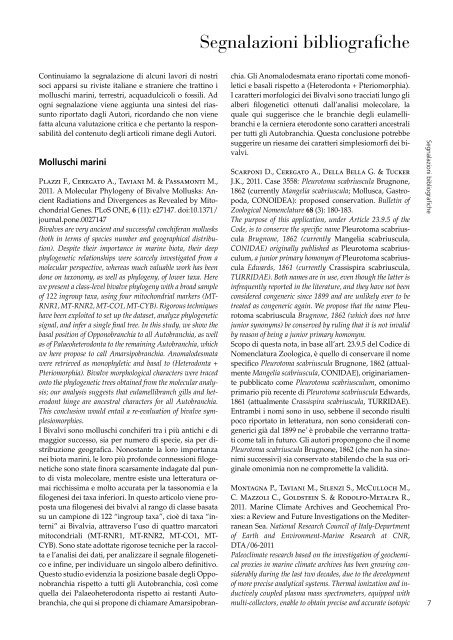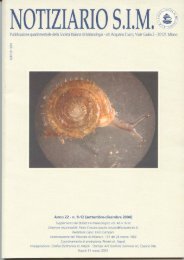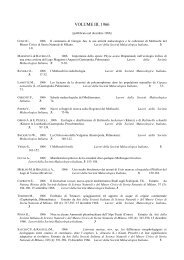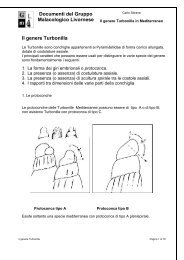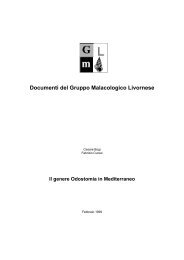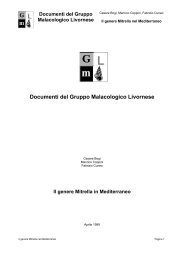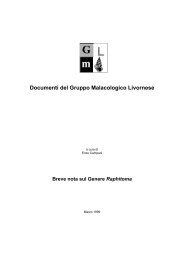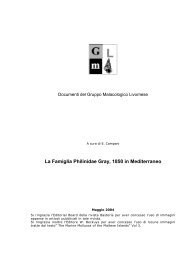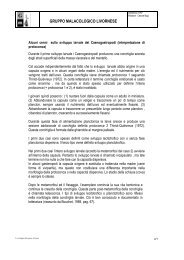Segnalazioni bibliograficheContinuiamo la segnalazione <strong>di</strong> alcuni lavori <strong>di</strong> nostrisoci apparsi su riviste italiane e straniere che trattino imolluschi marini, terrestri, acquadulcicoli o foss<strong>il</strong>i. Adogni segnalazione viene aggiunta una sintesi del riassuntoriportato dagli Autori, ricordando che non vienefatta alcuna valutazione critica e che pertanto la responsab<strong>il</strong>itàdel contenuto degli articoli rimane degli Autori.Molluschi mariniPlazzi F., Ceregato A., Taviani M. & Passamonti M.,2011. A Molecular Phylogeny of Bivalve Mollusks: AncientRa<strong>di</strong>ations and Divergences as Revealed by MitochondrialGenes. PLoS ONE, 6 (11): e27147. doi:10.1371/journal.pone.0027147Bivalves are very ancient and successful conchiferan mollusks(both in terms of species number and geographical <strong>di</strong>stribution).Despite their importance in marine biota, their deepphylogenetic relationships were scarcely investigated from amolecular perspective, whereas much valuable work has beendone on taxonomy, as well as phylogeny, of lower taxa. Herewe present a class-level bivalve phylogeny with a broad sampleof 122 ingroup taxa, using four mitochondrial markers (MT-RNR1, MT-RNR2, MT-CO1, MT-CYB). Rigorous techniqueshave been exploited to set up the dataset, analyze phylogeneticsignal, and infer a single final tree. In this study, we show thebasal position of Opponobranchia to all Autobranchia, as wellas of Palaeoheterodonta to the remaining Autobranchia, whichwe here propose to call Amarsipobranchia. Anomalodesmatawere retrieved as monophyletic and basal to (Heterodonta +Pteriomorphia). Bivalve morphological characters were tracedonto the phylogenetic trees obtained from the molecular analysis;our analysis suggests that eulamellibranch g<strong>il</strong>ls and heterodonthinge are ancestral characters for all Autobranchia.This conclusion would enta<strong>il</strong> a re-evaluation of bivalve symplesiomorphies.I Bivalvi sono molluschi conchiferi tra i più antichi e <strong>di</strong>maggior successo, sia per numero <strong>di</strong> specie, sia per <strong>di</strong>stribuzionegeografica. Nonostante la loro importanzanei biota marini, le loro più profonde connessioni f<strong>il</strong>ogenetichesono state finora scarsamente indagate dal punto<strong>di</strong> vista molecolare, mentre esiste una letteratura ormairicchissima e molto accurata per la tassonomia e laf<strong>il</strong>ogenesi dei taxa inferiori. In questo articolo viene propostauna f<strong>il</strong>ogenesi dei bivalvi al rango <strong>di</strong> classe basatasu un campione <strong>di</strong> 122 “ingroup taxa”, cioè <strong>di</strong> taxa “interni”ai Bivalvia, attraverso l’uso <strong>di</strong> quattro marcatorimitocondriali (MT-RNR1, MT-RNR2, MT-CO1, MT-CYB). Sono state adottate rigorose tecniche per la raccoltae l’analisi dei dati, per analizzare <strong>il</strong> segnale f<strong>il</strong>ogeneticoe infine, per in<strong>di</strong>viduare un singolo albero definitivo.Questo stu<strong>di</strong>o evidenzia la posizione basale degli Opponobranchiarispetto a tutti gli Autobranchia, così comequella dei Palaeoheterodonta rispetto ai restanti Autobranchia,che qui si propone <strong>di</strong> chiamare Amarsipobranchia.Gli Anomalodesmata erano riportati come monof<strong>il</strong>eticie basali rispetto a (Heterodonta + Pteriomorphia).I caratteri morfologici dei Bivalvi sono tracciati lungo glialberi f<strong>il</strong>ogenetici ottenuti dall’analisi molecolare, laquale qui suggerisce che le branchie degli eulamellibranchie la cerniera eterodonte sono caratteri ancestraliper tutti gli Autobranchia. Questa conclusione potrebbesuggerire un riesame dei caratteri simplesiomorfi dei bivalvi.Scarponi D., Ceregato A., Della Bella G. & TuckerJ.K., 2011. Case 3558: Pleurotoma scabriuscula Brugnone,1862 (currently Mangelia scabriuscula; Mollusca, Gastropoda,CONOIDEA): proposed conservation. Bulletin ofZoological Nomenclature 68 (3): 180-183.The purpose of this application, under Article 23.9.5 of theCode, is to conserve the specific name Pleurotoma scabriusculaBrugnone, 1862 (currently Mangelia scabriuscula,CONIDAE) originally published as Pleurotoma scabriusculum,a junior primary homonym of Pleurotoma scabriusculaEdwards, 1861 (currently Crassispira scabriuscula,TURRIDAE). Both names are in use, even though the latter isinfrequently reported in the literature, and they have not beenconsidered congeneric since 1899 and are unlikely ever to betreated as congeneric again. We propose that the name Pleurotomascabriuscula Brugnone, 1862 (which does not havejunior synonyms) be conserved by ruling that it is not invalidby reason of being a junior primary homonym.Scopo <strong>di</strong> questa nota, in base all’art. 23.9.5 del Co<strong>di</strong>ce <strong>di</strong>Nomenclatura Zoologica, è quello <strong>di</strong> conservare <strong>il</strong> nomespecifico Pleurotoma scabriuscula Brugnone, 1862 (attualmenteMangelia scabriuscula, CONIDAE), originariamentepubblicato come Pleurotoma scabriusculum, omonimoprimario più recente <strong>di</strong> Pleurotoma scabriuscula Edwards,1861 (attualmente Crassispira scabriuscula, TURRIDAE).Entrambi i nomi sono in uso, sebbene <strong>il</strong> secondo risultipoco riportato in letteratura, non sono considerati congenericigià dal 1899 ne’ è probab<strong>il</strong>e che verranno trattaticome tali in futuro. Gli autori propongono che <strong>il</strong> nomePleurotoma scabriuscula Brugnone, 1862 (che non ha sinonimisuccessivi) sia conservato stab<strong>il</strong>endo che la sua originaleomonimia non ne compromette la vali<strong>di</strong>tà.Montagna P., Taviani M., S<strong>il</strong>enzi S., McCulloch M.,C. Mazzoli C., Goldstein S. & Rodolfo-Metalpa R.,2011. Marine Climate Archives and Geochemical Proxies:a Review and Future Investigations on the Me<strong>di</strong>terraneanSea. National Research Counc<strong>il</strong> of Italy-Departmentof Earth and Environment-Marine Research at CNR,DTA/06-2011Paleoclimate research based on the investigation of geochemicalproxies in marine climate archives has been growing considerablyduring the last two decades, due to the developmentof more precise analytical systems. Thermal ionization and inductivelycoupled plasma mass spectrometers, equipped withmulti-collectors, enable to obtain precise and accurate isotopicSegnalazioni bibliografiche7
Segnalazioni bibliografiche8data, an essential requirement for reliable reconstructions ofthe physical and chemical marine parameters. In the last 5years, part of the paleoclimate investigation focused on theMe<strong>di</strong>terranean has been carried out using these cutting-edgeanalytical techniques through international collaborationsamong Italian, Australian and American scientists. Specimensof shallowand deep-water corals collected in the Me<strong>di</strong>terraneanSea, in the Atlantic and Pacific Oceans, have been analysedwith laser ablation and solution ICP-MS and with athermal ionization mass spectrometer. The correlation betweenLi, Mg, P, normalized to Ca, and the Nd and B isotopic compositionof the coral skeletons with the most important marineparameters has enabled to develop and validate new geochemicalproxies. The derived calibration equations can now be appliedto well-dated foss<strong>il</strong> corals with the aim to reconstruct theclimate variations in the past. This article reviews some of theprincipal results achieved in the last 5 years by the authorsand present some future <strong>di</strong>rections on the application of geochemistryto coral investigation.La ricerca sul paleoclima basata sull’indagine degli in<strong>di</strong>cigeochimici negli archivi climatici marini si è accresciutain modo considerevole durante gli ultimi vent’anni,come conseguenza dello sv<strong>il</strong>uppo <strong>di</strong> più precisi sistemi<strong>di</strong> analisi. La ionizzazione termica e degli spettrometri <strong>di</strong>massa ad accoppiamento induttivo del plasma, equipaggiaticon multicollettori, permette <strong>di</strong> ottenere dati isotopiciprecisi ed accurati, requisito essenziale per ricostruzioniaffidab<strong>il</strong>i dei parametri chimico-fisici marini. Negliultimi 5 anni, parte dell’indagine paleoclimatica focalizzatasul Me<strong>di</strong>terraneo, è stata condotta ut<strong>il</strong>izzando questetecnologie analitiche d’avanguar<strong>di</strong>a attraverso collaborazioniinternazionali tra ricercatori italiani, australianie americani. Esemplari <strong>di</strong> coralli <strong>di</strong> piattaforma e <strong>di</strong>profon<strong>di</strong>tà raccolti in Me<strong>di</strong>terraneo e negli oceani Atlanticoe Pacifico, sono stati analizzati attraverso l’ablazionelaser e soluzioni ICP-MS e con uno spettrometro <strong>di</strong> massaa ionizzazione termica. La correlazione tra Li, Mg, P,normalizzata al Ca, e la composizione isotopica <strong>di</strong> Nd eB degli scheletri <strong>di</strong> coralli, con i più importanti parametrimarini ha permesso <strong>di</strong> sv<strong>il</strong>uppare e convalidare nuoviin<strong>di</strong>ci geochimici. Le equazioni <strong>di</strong> calibrazione che nederivano, possono essere ora applicate a coralli foss<strong>il</strong>iben datati per ricostruire le variazioni climatiche delpassato. Questo articolo è una rassegna dei principali risultatiottenuti negli ultimi 5 anni dagli autori e presentaalcune possib<strong>il</strong>i <strong>di</strong>rezioni dell’applicazione della geochimicaallo stu<strong>di</strong>o dei coralli.Crocetta F., Bonomolo G., Albano P.G., Barco A.,Houart R. & Oliverio M., 2011. The status of the northeasternAtlantic and Me<strong>di</strong>terranean small mussel dr<strong>il</strong>lsof the Ocinebrina aciculata complex (Mollusca: Gastropoda:Muricidae), with the description of a new species.Scientia Marina: 1-13, 00(0) 000-000, Barcelona (Spain)doi: 10.3989/scimar.03395.02The northeastern Atlantic and Me<strong>di</strong>terranean small musseldr<strong>il</strong>ls of the Ocinebrina aciculata complex are here revisedand consist of at least 3 species. The type species, Ocinebrinaaciculata (Lamarck, 1822), characterized by a slender shellwith rounded whorls and primary and secondary spiral cordsof approximately sim<strong>il</strong>ar size, lives throughout the northeasternAtlantic and Me<strong>di</strong>terranean Sea at depths usually rangingbetween 0 and 105 m. Its synonymy is here stab<strong>il</strong>ized by aneotype selection for Murex corallinus Scacchi, 1836. Ocinebrinacorallinoides Pallary, 1912 (=Ocinebrina buzzurroiCecalupo and Mariani, 2008, new synonymy), characterizedby a strongly elongate and weakly convex shell andprimary and secondary spiral cords of approximately sim<strong>il</strong>arsize, is endemic to the Gulf of Gabès and is here considered a<strong>di</strong>stinct species, pen<strong>di</strong>ng genetic stu<strong>di</strong>es. Ocinebrina reinain. sp. is here described from the central Me<strong>di</strong>terranean Sea(where it is sympatric with O. aciculata) on the basis of morphological<strong>di</strong>agnostic features of shell (rarest presence of labraltooth, commoner presence of infrasutural apertural denticle,dark spots on the ribs and spiral sculpture with <strong>di</strong>fferentlysized primary and secondary cords and smaller threads) andradula, confirmed by genetic data. Divergence in COI sequenceswith sympatric samples of O. aciculata (>7%), confirmtheir status as a <strong>di</strong>stinct species. A comparative table reporting<strong>di</strong>agnostic features of the congeneric species of thecomplex and those with which the new species was previouslymisidentified is offered.Si revisionano le specie atlantiche e me<strong>di</strong>terranee delcomplex dell’Ocinebrina aciculata, che sono almeno tre.La specie tipo, Ocinebrina aciculata (Lamarck, 1822), è caratterizzatada una conchiglia sott<strong>il</strong>e con giri arrotondatie corde spirali primarie e secondarie della stessa <strong>di</strong>mensione,e vive nell’Atlantico nord-orientale e nel Me<strong>di</strong>terraneoa profon<strong>di</strong>tà tra 0 e 105 m. La sua sinonimia è quistab<strong>il</strong>izzata dalla selezione <strong>di</strong> un neotipo per Murex corallinusScacchi, 1836. Ocinebrina corallinoides Pallary,1912 (= Ocinebrina buzzurroi Cecalupo and Mariani, 2008,nuova sinonimia) è endemica del Golfo <strong>di</strong> Gabès ed èqui considerata una specie <strong>di</strong>stinta in attesa <strong>di</strong> stu<strong>di</strong> genetici.È caratterizzata da una conchiglia fortemente allungatae debolmente convessa, e corde primarie e secondarieapprossimativamente della stessa <strong>di</strong>mensione.Ocinebrina reinai n. sp. viene descritta dal Me<strong>di</strong>terraneocentrale (dove è simpatrica con O. aciculata) sulla base <strong>di</strong>caratteri morfologici <strong>di</strong>agnostici (presenza più rara deldente labiale, presenza più comune nell’apertura deldente infrasuturale, macchie nere sulle coste e sculturaspirale con corde primarie e secondarie <strong>di</strong> <strong>di</strong>mensioni<strong>di</strong>fferenti, e presenza <strong>di</strong> piccoli threads) e radula, confermatida dati genetici. Le <strong>di</strong>fferenze nella sequenza delgene COI tra questa ed esemplari simpatrici <strong>di</strong> O. aciculata(> 7%) confermano <strong>il</strong> loro stato <strong>di</strong> specie <strong>di</strong>stinte. Infine,viene offerta una tavola comparativa riportante icaratteri <strong>di</strong>agnostici delle specie congeneriche del complexe <strong>di</strong> quelle con cui la nuova specie è stata confusa inprecedenza.Angeletti L., Taviani M., 2011. Entrapment, preservationand incipient foss<strong>il</strong>ization of benthic predatory molluscswithin deep-water coral frames in the Me<strong>di</strong>terraneanSea. Article in press, Elsevier Masson SAS. GEO-BIO-544; No. of Pages 6. Ava<strong>il</strong>able online at SciVerseScienceDirect www.science<strong>di</strong>rect.comHolocene Madrepora-Lophelia subfoss<strong>il</strong> frames recovered atca. 690 m from deep-water coral grounds south of Malta (Strait
- Page 4 and 5: Verbale:Riunione del Consiglio Dire
- Page 6 and 7: Riteniamo doveroso ringraziare Igna
- Page 10 and 11: of Sicily, Central Mediterranean Se
- Page 12 and 13: on its occurrence. We suggest the a
- Page 14 and 15: in un’area compresa tra l’alta
- Page 16 and 17: partiti dall’elenco sistematico d
- Page 18 and 19: Chirli C. & Linse U., 2011. The Ple
- Page 20 and 21: (Gastropoda, Muricidae, Coralliophi
- Page 22 and 23: Delongueville C., Scaillet R. & Afo
- Page 24 and 25: dre: Veneroida (suite 8), Super-fam
- Page 26 and 27: Notiziario S.I.M. 30 (1) p. 01-02 g
- Page 28 and 29: Notiziario S.I.M. 30 (1) p. 03-11 g
- Page 30 and 31: Il Genere Lindapterys Petuch, 1987
- Page 32 and 33: Il Genere Lindapterys Petuch, 1987
- Page 34 and 35: arrotondate; sugli ultimi giri si s
- Page 36 and 37: turelle, 4ème série - section A.
- Page 38 and 39: osi esemplari, anche se non penso c
- Page 40 and 41: RingraziamentiRingrazio Enzo Campan
- Page 42 and 43: Chilostoma achates achates (Rossmä
- Page 44 and 45: - Varietà rhaeticum (Strobel, 1857
- Page 46 and 47: Considerazioni tassonomiche su alcu
- Page 48 and 49: Fig. 9. Forme intermedie fra C. zon
- Page 50 and 51: Figura 11. A. Chilostoma zonatum fl
- Page 52 and 53: Bi o n d e l l o: As much as an app
- Page 54 and 55: cuzione da considerare è cockle ha
- Page 56 and 57: Notiziario S.I.M. 30 (1) p. 31-34 g
- Page 58 and 59:
BIVALVIA Frequenza AmbienteArca noa
- Page 60 and 61:
Notiziario S.I.M. 30 (1) p. 35-36 g
- Page 62:
SommarioCuriosità1 Renda W. La Rub


